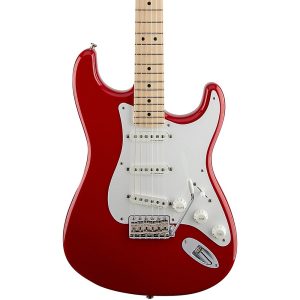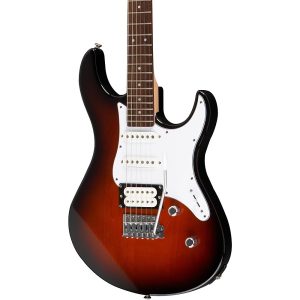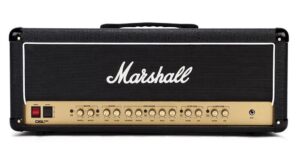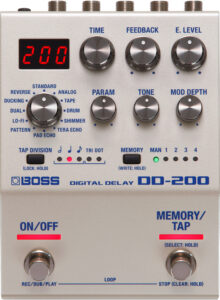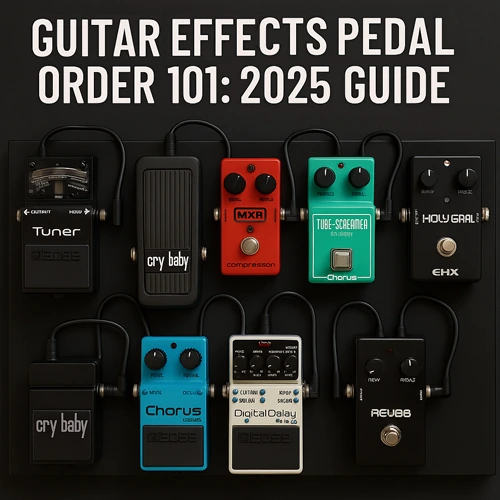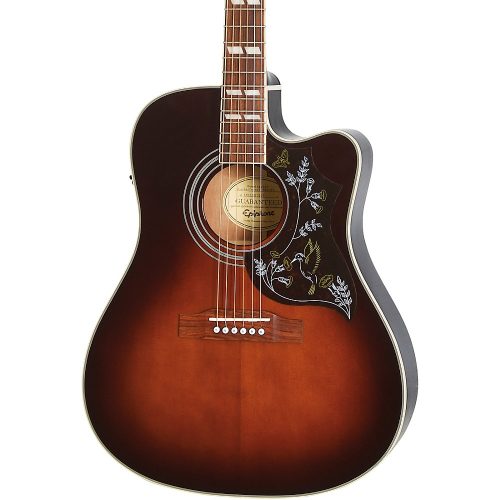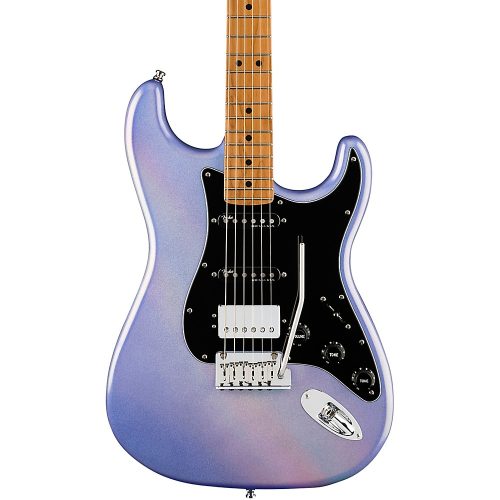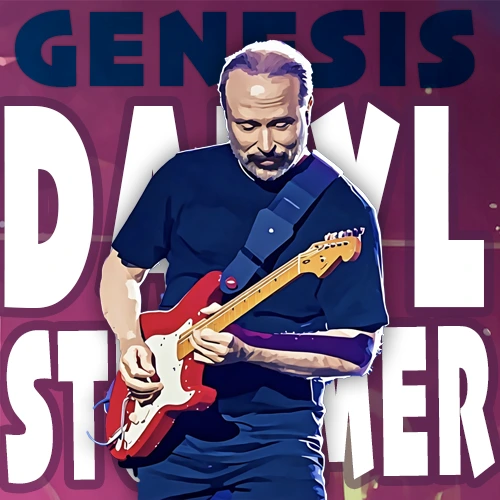
Table of Contents
Imagine this: it’s 1980, and after a Genesis rehearsal, Phil Collins offers a Milwaukee guitarist a ride back into London. Casually, Phil pops in a cassette and says, “I wanted to play you something.” What comes through the car speakers is a moody, haunting track with just keyboards and a drum machine – no big drum fill yet, no indication this would become one of the most recognizable songs in pop history.
That guitarist was Daryl Stuermer, and that song was “In the Air Tonight.” Later that year, Daryl would be in Village Recorders in LA, creating the razor-sharp guitar parts that would help define not just Phil’s solo career, but the entire sound of 1980s pop rock. Using what he remembers as a SUNTECH guitar with EMG pickups straight into an amp, he laid down those cutting rhythm parts that millions still try to replicate today.
But here’s the thing about Daryl that most people don’t realize: he wasn’t just Phil’s guitarist. He was a co-writer on multiple hit songs, the architect of some of the most sophisticated pop arrangements ever recorded, and a player who seamlessly moved between Genesis’s progressive complexity and Phil’s radio-friendly hooks. When that Milwaukee kid who started out in jazz fusion clubs ended up playing to stadium crowds worldwide, it wasn’t luck – it was pure musical intelligence meeting perfect timing.
From Milwaukee Jazz Clubs to Stadium Stages
Growing up in Milwaukee, Daryl Mark Stuermer was just another working-class kid learning guitar. His father had an incredible collection of classical and flamenco records, which planted seeds that would bloom decades later in his sophisticated chord voicings and fingerpicking techniques. But first, he had to fall in love with The Ventures.
“That really got me going,” Daryl recalls about discovering the instrumental surf rock legends at age eleven. By fifteen, he’d moved into jazz territory, studying the complex harmonic concepts that would later separate his pop playing from typical rock guitarists.
The trajectory that led to Genesis started in the most Milwaukee way possible – at a local jazz fusion club called Sardino’s Boulder Ring. His band Sweet Bottom was the house act, playing five nights a week for twenty bucks a pop (thirty on Saturdays if they were lucky). They were crushing it on the local scene, but it was still just local scene money.
Everything changed when Frank Zappa’s band rolled into town in 1975. George Duke, Zappa’s keyboardist, sat in with Sweet Bottom that night and was blown away by this 22-year-old guitarist who could hang with anyone. When Duke was jamming with different musicians throughout the evening, Daryl started packing up his guitar, thinking it was someone else’s turn.
“Where you going, kid?” Duke asked. “Oh, I thought maybe I’d give somebody else a chance.” ” Just stay up here.”
That moment changed everything. Duke remembered Daryl’s name and later recommended him to Jean-Luc Ponty, the virtuoso jazz violinist who was putting together his first American band. After a nerve-wracking audition where Daryl sight-read Ponty’s complex compositions (including the fiendish “Poly Folk Dance” in 9/8 time), he landed the gig.
Three years and three albums with Ponty gave Daryl credibility in the fusion world, but when Ponty didn’t have touring plans in late 1977, another opportunity emerged. Alphonso Johnson, the legendary bass player from Weather Report, had auditioned for Genesis as their touring bassist but didn’t get the job. However, he recommended Daryl as someone who could handle both guitar and bass duties.
The audition in New York was make-or-break. Genesis had already tried about twenty guitarists in England with no luck, and Daryl was their first American candidate. Mike Rutherford sent him a cassette with five songs – working titles that would later become classics like “Follow You Follow Me” (then called “Calypso”) and “Down and Out” (labeled “5/8” for its time signature).
Unlike the other guitarists who showed up asking what key the songs were in, Daryl had learned every note. When Mike said those magic words – “I think you’re the one” – after just a few minutes of playing, it wasn’t just about talent. It was about preparation meeting opportunity.
The Classics: Four Tracks That Defined 80s Guitar
“In the Air Tonight” (1981) – The track that launched a thousand drum machine experiments starts with Daryl’s clean, cutting Stratocaster creating an atmosphere that’s both intimate and massive. That opening riff isn’t flashy – it’s surgical precision, every note placed exactly where it needs to be. The genius is in the restraint; while Phil’s vocal builds tension, Daryl’s guitar provides the rhythmic foundation that makes that famous drum fill land like a sledgehammer. Recorded direct into the board at Village Recorders, it’s the sound of controlled aggression.
“Easy Lover” (1984) – This Philip Bailey collaboration showcases Daryl’s ability to serve a pop melody without sacrificing sophistication. The solo that’s become viral on Instagram wasn’t planned – it was pure first-take inspiration using what he believes was his Roland guitar synthesizer through a Marshall stack. The fast scalar run that trips up most guitarists attempting covers? That’s straight jazz vocabulary applied to a pop context, something only a player with Daryl’s fusion background could pull off so naturally.
“Something Happened on the Way to Heaven” (1989) – Here’s where Daryl’s songwriting contributions shine. Those sophisticated chord changes in the bridge? That’s all Daryl. Phil heard a similar progression in another Daryl composition and said, “Put those chords in there.” The result transforms what could have been a straightforward pop song into something harmonically rich enough to keep jazz guitarists interested, yet accessible enough for radio play.
“Sussudio” (1985) – The most divisive track in Phil’s catalog, but from a guitar perspective, it’s brilliant. Daryl’s choppy, syncopated rhythm playing – recorded direct with heavy compression – creates that distinctly 80s funk-rock groove that influenced everyone from Michael Jackson’s session players to Prince’s Minneapolis crew. The technique required to maintain that pocket-perfect timing while keeping every note crisp and articulate is deceptively difficult.
Master His Sound: The Daryl Stuermer Way
The Three-Approach Philosophy
What separates Daryl from typical session guitarists isn’t just his technical ability – it’s his musical intelligence. Coming from jazz fusion, he approaches every song with three perspectives simultaneously: the harmonic content (what chords would make this more interesting?), the rhythmic foundation (how can I lock with the drums better?), and the arrangement role (what does this song actually need from guitar?).
This shows up most clearly in his Genesis work, where he essentially plays three different roles depending on the song. On Gabriel-era material, he’s the lead guitarist, handling Steve Hackett’s intricate melodic lines. On Collins-era tracks, he might be playing bass on a Steinberger while Mike Rutherford handles rhythm guitar. And on new material, he’s often the arrangement architect, suggesting chord voicings that transform simple progressions into something sophisticated.
The Clean-to-Dirty Spectrum
Daryl’s tone philosophy is refreshingly practical: match the tool to the job. For ballads like “One More Night,” he’s using a clean Stratocaster through a JC-120 with chorus and digital delay, creating space for Phil’s intimate vocal delivery. For aggressive tracks like “Sussudio,” it’s straight into the board with 1176 compression, creating that in-your-face attack that cuts through busy arrangements.
The key insight is his restraint with effects. Unlike guitarists who drown their signal in processing, Daryl uses effects as specific colors for specific moments. That chorus on “One More Night” isn’t there because it sounds cool – it’s there because it creates the illusion of width in what’s essentially a sparse arrangement.
Jazz Fusion Meets Pop Sensibility
Here’s what makes Daryl special: he can play sophisticated jazz harmony in pop contexts without making it sound pretentious. Those extended chords in “Something Happened on the Way to Heaven” would sound academic in lesser hands, but Daryl’s phrasing and touch make them feel inevitable rather than calculated.
This comes from understanding voice leading – how individual notes within chords connect to create smooth motion. It’s classical composition technique applied to pop guitar, something most rock players never learn because they’re too busy learning pentatonic scales.
How to Play “Easy Lover” by Philip Bailey & Phil Collins on Guitar
Want to nail that viral guitar solo that’s been lighting up Instagram? “Easy Lover” showcases Daryl’s jazz fusion chops in a pop context, and that fast scalar run is what separates the pretenders from the players. This is the track that proves technical ability and commercial appeal can coexist perfectly.
The key to getting this right is understanding that Daryl’s approach comes from jazz vocabulary, not typical rock patterns. That lightning-fast line that trips up most guitarists? It’s pure bebop phrasing applied to a pop progression. The solo was recorded in one take using what Daryl believes was his Roland guitar synthesizer through a Marshall stack – first-take inspiration captured forever.
Watch this detailed breakdown with tablature that shows you exactly how to play the complete solo:
The Gear That Built Pop History
Electric Guitars
Fender Stratocaster (Eric Clapton Model) – Daryl’s primary weapon throughout the Phil Collins years, loaded with Lace Sensor pickups and featuring the TBX tone control system. The Clapton model’s softer V-neck profile suited his jazz-influenced fingering, while the active electronics provided the output needed to drive those cranked Marshall amps. He eventually swapped the neck for a more comfortable modern profile with medium jumbo frets, proving that even pros modify their gear for better playability.
Modern Alternatives:
- Fender Player Stratocaster – Classic Strat tones with modern reliability and comfort.
- Fender Vintera ’60s Stratocaster – Vintage-spec pickups deliver that authentic ’80s pop tone.
Godin LGXT and DS-1 – In recent years, Daryl switched to these Canadian-made instruments for their superior ergonomics and built-in features. The LGXT combined guitar and synth capabilities, while his signature DS-1 model eliminated the synth components for pure guitar focus. The high-definition revoicing circuit provides active output without the battery drain issues of typical active systems.
Budget Alternative: Yamaha Pacifica 112V – HSS pickup configuration handles any pop style you throw at it
Amplification
Marshall DSL Series – Daryl’s go-to for that cutting 80s rock tone. The two-channel design allows instant switching between clean passages and overdriven sections, while the built-in reverb adds depth without muddying the attack. For “Sussudio”-style aggression, crank the gain; for “One More Night” intimacy, stay clean with chorus.
Roland JC-120 – The secret weapon behind many of those pristine clean tones. The built-in chorus creates that shimmering width heard on ballads, while the solid-state reliability means consistent tone night after night on tour. Not glamorous, but utterly dependable.
Budget Options:
- Boss Katana 100 – Modeling technology that actually nails those vintage clean and overdrive tones
- Fender Blues Junior – Tube warmth for bedroom to small club volumes
Effects
Boss DD-200 Digital Delay – The world’s first stompbox digital delay, and Daryl’s choice throughout the mid-80s. That distinctive early digital sound – not warm like tape, not harsh like modern delays – became part of the 80s guitar DNA. The 800ms maximum delay time was perfect for those spacious ballad textures.
Strymon Ola Chorus – Daryl’s modern choice for stereo chorus effects. The dBucket circuit captures vintage analog warmth while providing stereo width that mono effects can’t match.
Essential Settings:
Marshall DSL (Clean Channel):
- Gain: 3/10
- Volume: 6/10
- EQ: Bass 4/10, Mid 6/10, Treble 7/10
- Reverb: 3/10
Marshall DSL (Overdrive Channel – “Sussudio” tone):
- Gain: 7/10
- Volume: Match clean level
- EQ: Bass 5/10, Mid 7/10, Treble 6/10
- Use sparingly – it’s an effect, not a constant sound
The Hidden Songwriter: Tracks You Didn’t Know He Wrote
Most fans know Daryl as Phil’s guitarist, but few realize his songwriting contributions shaped some of the biggest hits. This isn’t just rhythm guitar – this is compositional architecture at the highest level.
“I Don’t Wanna Know” – Originally titled “Fong” (Phil’s working titles were always mysterious), this was entirely Daryl’s composition. He played it for Phil during demo sessions at Phil’s home studio, not expecting anything beyond feedback from a friend. Phil’s response? “Do you mind if I write lyrics to this?” The result became a deep cut that showcased sophisticated jazz harmony in a pop context – something only Daryl’s fusion background could deliver.
The chord progression is legitimately complex. Where typical pop songs might use three chords, Daryl constructed voice-leading movements that rival Broadway standards. When he plays it live today, you can see why – every chord requires a complete hand position change, creating melodic bass lines and inner voice movements that most rock guitarists never consider.
“Something Happened on the Way to Heaven” – Phil had the basic verse and chorus, but Daryl transformed the bridge into something special. Those jazz-influenced chord substitutions that make the song harmonically interesting? All Daryl. Phil recognized gold when he heard it, essentially saying,
“Put those chords from that other song you played me right here.”
This collaborative process reveals something important about hit songwriting: it’s not always one person’s vision. Sometimes it’s recognizing when someone else’s musical ideas serve your song better than your original concept.
“Doesn’t Anybody Stay Together Anymore” – Another co-write where Daryl provided the missing puzzle piece. Phil had everything except the bridge section – that crucial moment where songs either soar or sag. Daryl’s contribution provided the harmonic sophistication that elevated a good song into something album-worthy.
The financial impact was life-changing. As Daryl puts it, “One of the songs bought the house.” In 1991, he purchased his current Milwaukee home with songwriting royalties – proving that musical intelligence pays better than flashy solos.
What the Guitar Community Really Thinks
Daryl sparks fascinating debates in guitar circles. The Genesis fanbase splits into two camps: purists who worship Steve Hackett’s original solos, and players who appreciate Daryl’s jazz-influenced reinterpretations. One Reddit user perfectly captured this divide:
“I got roasted for saying Daryl’s ‘Firth’ solo absolutely rages,”
While another defended him:
“There are things that each player does differently, does better.”
The fusion crowd has always recognized his abilities. As one longtime fan noted: “Check out the stuff Daryl did back in the day with Jean-Luc Ponty before he started working with Genesis. He’s an amazing Jazz-Rock Fusion player.” This perspective highlights something casual listeners miss – Daryl didn’t learn sophistication from Phil Collins; he brought it with him. One YouTube commenter summed it up:
“His solo on Easy Lover is the perfect pop song guitar solo in my opinion. It’s technically demanding but serves the song completely.”
The gear community respects his practical approach. Unlike players who chase vintage mojo or boutique effects, Daryl focused on tools that worked reliably night after night. His switch from Fender to Godin guitars raised eyebrows initially, but seasoned players understood – comfort and consistency matter more than brand prestige when you’re playing 150 shows a year.
Perhaps the most telling community insight comes from discovering his songwriting contributions. When fans learn he co-wrote “I Don’t Wanna Know” and contributed key chord progressions to other hits, their respect deepens. As one Reddit user listed:
“Daryl co-wrote some songs with Phil: Only You Know and I Know, I Don’t Wanna Know, Doesn’t Anybody Stay Together Anymore, Something Happened on the Way to Heaven, The Least You Can Do.”
The consensus? He’s criminally underrated by casual fans but deeply respected by working musicians who understand that blazing chops mean nothing without knowing when to use them.
Daryl Stuermer: Career By Numbers
Playing Through Parkinson’s: A Guitarist’s Courage
In 2023, Daryl revealed something that explains why certain songs had disappeared from his setlists: he’d been diagnosed with Parkinson’s disease. The revelation came not as a sob story, but as a matter-of-fact explanation of his current musical reality.
“Rhythmically, it has a lot of effect for me to play a steady rhythm,”
Daryl explains with characteristic directness. Songs like Genesis’s “Turn It On Again” – that simple, repetitive ding-ding-ding pattern – became surprisingly difficult.
“I never had a problem playing that, and I’m going, ‘Why am I having a problem playing this?'”
The cruel irony is that complex passages often remain manageable while simple, steady rhythms become challenging. That fast scalar run in “Easy Lover” that trips up healthy guitarists? Still beyond most players’ abilities. But maintaining a steady eighth-note pattern for three minutes straight? That’s where Parkinson’s creates obstacles.
Yet Daryl’s approach mirrors his entire career philosophy: adapt and overcome. Physical therapy, medication, and most importantly, mental adjustment. “Your brain finally finds a different way,” he notes. “If this is the roadblock, it goes around it.”
He’s discovered workarounds that allow him to keep performing. Some songs required new fingering approaches; others needed slight arrangement modifications. The key insight: accepting limitations while maximizing remaining strengths.
This isn’t retirement – it’s evolution. Daryl continues touring with his band, choosing repertoire that works within his current capabilities while still delivering the musical sophistication his audiences expect. It’s a masterclass in professional adaptation that younger musicians would be wise to study.
The courage required to discuss this publicly – especially in a culture that often discards aging musicians – reflects the same honesty that’s characterized his entire career. No pretense, no dramatics, just acknowledgment of reality and determination to keep making music.
FAQ: Everything You Want to Know About Daryl Stuermer
Q: How did Phil Collins hear about Daryl’s guitar playing? A: Through Genesis. When Steve Hackett left the band in 1977, they needed a touring guitarist who could also play bass. Alphonso Johnson from Weather Report recommended Daryl after his own Genesis audition was unsuccessful.
Q: What’s the secret to playing “In the Air Tonight” correctly? A: The timing is tricky – most people think the hi-hat marks beat one, but it doesn’t. The real count starts when you hear the first hi-hat. Also, use a clean Stratocaster with just slight overdrive, not heavy distortion.
Q: Did Daryl really co-write major Phil Collins hits? A: Yes. He wrote “I Don’t Wanna Know” entirely and contributed essential chord progressions to “Something Happened on the Way to Heaven” and “Doesn’t Anybody Stay Together Anymore.” The royalties from these songs bought his house.
Q: How has Parkinson’s disease affected his playing? A: Steady, repetitive rhythms have become challenging, while complex passages often remain manageable. He’s adapted through new fingering techniques and medication, continuing to tour while choosing appropriate repertoire.
Q: What guitar should I buy to sound like Daryl? A: Any quality Stratocaster will get you close – the technique matters more than the specific instrument. A Fender Player Stratocaster or Godin Session would be excellent choices.
Q: Why don’t more guitarists talk about Daryl’s influence? A: He’s a musician’s musician – his sophistication is more obvious to players than to casual listeners. Session guitarists and pop arrangers understand his contributions better than rock fans looking for flashy solos.
Final Thoughts: The Sophisticated Simplicity of Daryl Stuermer
Daryl Stuermer proved that deep knowledge beats flashiness every time. His jazz fusion background gave Phil Collins’s hits harmonic depth that typical radio fare never achieved. The kid who learned 26 Genesis songs in a month became the professional who made “Sussudio” groove like a Prince track.
From Milwaukee clubs to stadium stages, Daryl represents something rare: a guitarist who got better by knowing when not to play. Those “simple” parts that millions try to copy? They only sound simple because he understood exactly what each song needed.
As Daryl puts it: “Sometimes being musical is more important than being fast.” In a world of YouTube shredders, that’s still the most important lesson of all.
To Daryl – nothing but love and respect from Get My Guitar and the entire guitarist community. Keep inspiring us all.
👉 Check out more deals and gear reviews on the Get My Guitar Blog.
👉 Join our guitarist community to share your finds and discuss all things guitar!
👉 Check out the very latest Guitar News.
Disclosure: This post contains affiliate links. If you purchase through these links, we may earn a commission at no extra cost to you.
Recent Posts
Imagine this: it's 1980, and after a Genesis rehearsal, Phil Collins offers a Milwaukee guitarist a ride back into [...]
Ever wonder why your pedalboard sounds like mud even though you've got quality gear? The answer usually comes down [...]
Do you ever find yourself air-drumming to your favorite track and thinking, "Man, I need to be playing this [...]
Blog Categories
Tags

Table of Contents
Imagine this: it’s 1980, and after a Genesis rehearsal, Phil Collins offers a Milwaukee guitarist a ride back into London. Casually, Phil pops in a cassette and says, “I wanted to play you something.” What comes through the car speakers is a moody, haunting track with just keyboards and a drum machine – no big drum fill yet, no indication this would become one of the most recognizable songs in pop history.
That guitarist was Daryl Stuermer, and that song was “In the Air Tonight.” Later that year, Daryl would be in Village Recorders in LA, creating the razor-sharp guitar parts that would help define not just Phil’s solo career, but the entire sound of 1980s pop rock. Using what he remembers as a SUNTECH guitar with EMG pickups straight into an amp, he laid down those cutting rhythm parts that millions still try to replicate today.
But here’s the thing about Daryl that most people don’t realize: he wasn’t just Phil’s guitarist. He was a co-writer on multiple hit songs, the architect of some of the most sophisticated pop arrangements ever recorded, and a player who seamlessly moved between Genesis’s progressive complexity and Phil’s radio-friendly hooks. When that Milwaukee kid who started out in jazz fusion clubs ended up playing to stadium crowds worldwide, it wasn’t luck – it was pure musical intelligence meeting perfect timing.
From Milwaukee Jazz Clubs to Stadium Stages
Growing up in Milwaukee, Daryl Mark Stuermer was just another working-class kid learning guitar. His father had an incredible collection of classical and flamenco records, which planted seeds that would bloom decades later in his sophisticated chord voicings and fingerpicking techniques. But first, he had to fall in love with The Ventures.
“That really got me going,” Daryl recalls about discovering the instrumental surf rock legends at age eleven. By fifteen, he’d moved into jazz territory, studying the complex harmonic concepts that would later separate his pop playing from typical rock guitarists.
The trajectory that led to Genesis started in the most Milwaukee way possible – at a local jazz fusion club called Sardino’s Boulder Ring. His band Sweet Bottom was the house act, playing five nights a week for twenty bucks a pop (thirty on Saturdays if they were lucky). They were crushing it on the local scene, but it was still just local scene money.
Everything changed when Frank Zappa’s band rolled into town in 1975. George Duke, Zappa’s keyboardist, sat in with Sweet Bottom that night and was blown away by this 22-year-old guitarist who could hang with anyone. When Duke was jamming with different musicians throughout the evening, Daryl started packing up his guitar, thinking it was someone else’s turn.
“Where you going, kid?” Duke asked. “Oh, I thought maybe I’d give somebody else a chance.” ” Just stay up here.”
That moment changed everything. Duke remembered Daryl’s name and later recommended him to Jean-Luc Ponty, the virtuoso jazz violinist who was putting together his first American band. After a nerve-wracking audition where Daryl sight-read Ponty’s complex compositions (including the fiendish “Poly Folk Dance” in 9/8 time), he landed the gig.
Three years and three albums with Ponty gave Daryl credibility in the fusion world, but when Ponty didn’t have touring plans in late 1977, another opportunity emerged. Alphonso Johnson, the legendary bass player from Weather Report, had auditioned for Genesis as their touring bassist but didn’t get the job. However, he recommended Daryl as someone who could handle both guitar and bass duties.
The audition in New York was make-or-break. Genesis had already tried about twenty guitarists in England with no luck, and Daryl was their first American candidate. Mike Rutherford sent him a cassette with five songs – working titles that would later become classics like “Follow You Follow Me” (then called “Calypso”) and “Down and Out” (labeled “5/8” for its time signature).
Unlike the other guitarists who showed up asking what key the songs were in, Daryl had learned every note. When Mike said those magic words – “I think you’re the one” – after just a few minutes of playing, it wasn’t just about talent. It was about preparation meeting opportunity.
The Classics: Four Tracks That Defined 80s Guitar
“In the Air Tonight” (1981) – The track that launched a thousand drum machine experiments starts with Daryl’s clean, cutting Stratocaster creating an atmosphere that’s both intimate and massive. That opening riff isn’t flashy – it’s surgical precision, every note placed exactly where it needs to be. The genius is in the restraint; while Phil’s vocal builds tension, Daryl’s guitar provides the rhythmic foundation that makes that famous drum fill land like a sledgehammer. Recorded direct into the board at Village Recorders, it’s the sound of controlled aggression.
“Easy Lover” (1984) – This Philip Bailey collaboration showcases Daryl’s ability to serve a pop melody without sacrificing sophistication. The solo that’s become viral on Instagram wasn’t planned – it was pure first-take inspiration using what he believes was his Roland guitar synthesizer through a Marshall stack. The fast scalar run that trips up most guitarists attempting covers? That’s straight jazz vocabulary applied to a pop context, something only a player with Daryl’s fusion background could pull off so naturally.
“Something Happened on the Way to Heaven” (1989) – Here’s where Daryl’s songwriting contributions shine. Those sophisticated chord changes in the bridge? That’s all Daryl. Phil heard a similar progression in another Daryl composition and said, “Put those chords in there.” The result transforms what could have been a straightforward pop song into something harmonically rich enough to keep jazz guitarists interested, yet accessible enough for radio play.
“Sussudio” (1985) – The most divisive track in Phil’s catalog, but from a guitar perspective, it’s brilliant. Daryl’s choppy, syncopated rhythm playing – recorded direct with heavy compression – creates that distinctly 80s funk-rock groove that influenced everyone from Michael Jackson’s session players to Prince’s Minneapolis crew. The technique required to maintain that pocket-perfect timing while keeping every note crisp and articulate is deceptively difficult.
Master His Sound: The Daryl Stuermer Way
The Three-Approach Philosophy
What separates Daryl from typical session guitarists isn’t just his technical ability – it’s his musical intelligence. Coming from jazz fusion, he approaches every song with three perspectives simultaneously: the harmonic content (what chords would make this more interesting?), the rhythmic foundation (how can I lock with the drums better?), and the arrangement role (what does this song actually need from guitar?).
This shows up most clearly in his Genesis work, where he essentially plays three different roles depending on the song. On Gabriel-era material, he’s the lead guitarist, handling Steve Hackett’s intricate melodic lines. On Collins-era tracks, he might be playing bass on a Steinberger while Mike Rutherford handles rhythm guitar. And on new material, he’s often the arrangement architect, suggesting chord voicings that transform simple progressions into something sophisticated.
The Clean-to-Dirty Spectrum
Daryl’s tone philosophy is refreshingly practical: match the tool to the job. For ballads like “One More Night,” he’s using a clean Stratocaster through a JC-120 with chorus and digital delay, creating space for Phil’s intimate vocal delivery. For aggressive tracks like “Sussudio,” it’s straight into the board with 1176 compression, creating that in-your-face attack that cuts through busy arrangements.
The key insight is his restraint with effects. Unlike guitarists who drown their signal in processing, Daryl uses effects as specific colors for specific moments. That chorus on “One More Night” isn’t there because it sounds cool – it’s there because it creates the illusion of width in what’s essentially a sparse arrangement.
Jazz Fusion Meets Pop Sensibility
Here’s what makes Daryl special: he can play sophisticated jazz harmony in pop contexts without making it sound pretentious. Those extended chords in “Something Happened on the Way to Heaven” would sound academic in lesser hands, but Daryl’s phrasing and touch make them feel inevitable rather than calculated.
This comes from understanding voice leading – how individual notes within chords connect to create smooth motion. It’s classical composition technique applied to pop guitar, something most rock players never learn because they’re too busy learning pentatonic scales.
How to Play “Easy Lover” by Philip Bailey & Phil Collins on Guitar
Want to nail that viral guitar solo that’s been lighting up Instagram? “Easy Lover” showcases Daryl’s jazz fusion chops in a pop context, and that fast scalar run is what separates the pretenders from the players. This is the track that proves technical ability and commercial appeal can coexist perfectly.
The key to getting this right is understanding that Daryl’s approach comes from jazz vocabulary, not typical rock patterns. That lightning-fast line that trips up most guitarists? It’s pure bebop phrasing applied to a pop progression. The solo was recorded in one take using what Daryl believes was his Roland guitar synthesizer through a Marshall stack – first-take inspiration captured forever.
Watch this detailed breakdown with tablature that shows you exactly how to play the complete solo:
The Gear That Built Pop History
Electric Guitars
Fender Stratocaster (Eric Clapton Model) – Daryl’s primary weapon throughout the Phil Collins years, loaded with Lace Sensor pickups and featuring the TBX tone control system. The Clapton model’s softer V-neck profile suited his jazz-influenced fingering, while the active electronics provided the output needed to drive those cranked Marshall amps. He eventually swapped the neck for a more comfortable modern profile with medium jumbo frets, proving that even pros modify their gear for better playability.
Modern Alternatives:
- Fender Player Stratocaster – Classic Strat tones with modern reliability and comfort.
- Fender Vintera ’60s Stratocaster – Vintage-spec pickups deliver that authentic ’80s pop tone.
Godin LGXT and DS-1 – In recent years, Daryl switched to these Canadian-made instruments for their superior ergonomics and built-in features. The LGXT combined guitar and synth capabilities, while his signature DS-1 model eliminated the synth components for pure guitar focus. The high-definition revoicing circuit provides active output without the battery drain issues of typical active systems.
Budget Alternative: Yamaha Pacifica 112V – HSS pickup configuration handles any pop style you throw at it
Amplification
Marshall DSL Series – Daryl’s go-to for that cutting 80s rock tone. The two-channel design allows instant switching between clean passages and overdriven sections, while the built-in reverb adds depth without muddying the attack. For “Sussudio”-style aggression, crank the gain; for “One More Night” intimacy, stay clean with chorus.
Roland JC-120 – The secret weapon behind many of those pristine clean tones. The built-in chorus creates that shimmering width heard on ballads, while the solid-state reliability means consistent tone night after night on tour. Not glamorous, but utterly dependable.
Budget Options:
- Boss Katana 100 – Modeling technology that actually nails those vintage clean and overdrive tones
- Fender Blues Junior – Tube warmth for bedroom to small club volumes
Effects
Boss DD-200 Digital Delay – The world’s first stompbox digital delay, and Daryl’s choice throughout the mid-80s. That distinctive early digital sound – not warm like tape, not harsh like modern delays – became part of the 80s guitar DNA. The 800ms maximum delay time was perfect for those spacious ballad textures.
Strymon Ola Chorus – Daryl’s modern choice for stereo chorus effects. The dBucket circuit captures vintage analog warmth while providing stereo width that mono effects can’t match.
Essential Settings:
Marshall DSL (Clean Channel):
- Gain: 3/10
- Volume: 6/10
- EQ: Bass 4/10, Mid 6/10, Treble 7/10
- Reverb: 3/10
Marshall DSL (Overdrive Channel – “Sussudio” tone):
- Gain: 7/10
- Volume: Match clean level
- EQ: Bass 5/10, Mid 7/10, Treble 6/10
- Use sparingly – it’s an effect, not a constant sound
The Hidden Songwriter: Tracks You Didn’t Know He Wrote
Most fans know Daryl as Phil’s guitarist, but few realize his songwriting contributions shaped some of the biggest hits. This isn’t just rhythm guitar – this is compositional architecture at the highest level.
“I Don’t Wanna Know” – Originally titled “Fong” (Phil’s working titles were always mysterious), this was entirely Daryl’s composition. He played it for Phil during demo sessions at Phil’s home studio, not expecting anything beyond feedback from a friend. Phil’s response? “Do you mind if I write lyrics to this?” The result became a deep cut that showcased sophisticated jazz harmony in a pop context – something only Daryl’s fusion background could deliver.
The chord progression is legitimately complex. Where typical pop songs might use three chords, Daryl constructed voice-leading movements that rival Broadway standards. When he plays it live today, you can see why – every chord requires a complete hand position change, creating melodic bass lines and inner voice movements that most rock guitarists never consider.
“Something Happened on the Way to Heaven” – Phil had the basic verse and chorus, but Daryl transformed the bridge into something special. Those jazz-influenced chord substitutions that make the song harmonically interesting? All Daryl. Phil recognized gold when he heard it, essentially saying,
“Put those chords from that other song you played me right here.”
This collaborative process reveals something important about hit songwriting: it’s not always one person’s vision. Sometimes it’s recognizing when someone else’s musical ideas serve your song better than your original concept.
“Doesn’t Anybody Stay Together Anymore” – Another co-write where Daryl provided the missing puzzle piece. Phil had everything except the bridge section – that crucial moment where songs either soar or sag. Daryl’s contribution provided the harmonic sophistication that elevated a good song into something album-worthy.
The financial impact was life-changing. As Daryl puts it, “One of the songs bought the house.” In 1991, he purchased his current Milwaukee home with songwriting royalties – proving that musical intelligence pays better than flashy solos.
What the Guitar Community Really Thinks
Daryl sparks fascinating debates in guitar circles. The Genesis fanbase splits into two camps: purists who worship Steve Hackett’s original solos, and players who appreciate Daryl’s jazz-influenced reinterpretations. One Reddit user perfectly captured this divide:
“I got roasted for saying Daryl’s ‘Firth’ solo absolutely rages,”
While another defended him:
“There are things that each player does differently, does better.”
The fusion crowd has always recognized his abilities. As one longtime fan noted: “Check out the stuff Daryl did back in the day with Jean-Luc Ponty before he started working with Genesis. He’s an amazing Jazz-Rock Fusion player.” This perspective highlights something casual listeners miss – Daryl didn’t learn sophistication from Phil Collins; he brought it with him. One YouTube commenter summed it up:
“His solo on Easy Lover is the perfect pop song guitar solo in my opinion. It’s technically demanding but serves the song completely.”
The gear community respects his practical approach. Unlike players who chase vintage mojo or boutique effects, Daryl focused on tools that worked reliably night after night. His switch from Fender to Godin guitars raised eyebrows initially, but seasoned players understood – comfort and consistency matter more than brand prestige when you’re playing 150 shows a year.
Perhaps the most telling community insight comes from discovering his songwriting contributions. When fans learn he co-wrote “I Don’t Wanna Know” and contributed key chord progressions to other hits, their respect deepens. As one Reddit user listed:
“Daryl co-wrote some songs with Phil: Only You Know and I Know, I Don’t Wanna Know, Doesn’t Anybody Stay Together Anymore, Something Happened on the Way to Heaven, The Least You Can Do.”
The consensus? He’s criminally underrated by casual fans but deeply respected by working musicians who understand that blazing chops mean nothing without knowing when to use them.
Daryl Stuermer: Career By Numbers
Playing Through Parkinson’s: A Guitarist’s Courage
In 2023, Daryl revealed something that explains why certain songs had disappeared from his setlists: he’d been diagnosed with Parkinson’s disease. The revelation came not as a sob story, but as a matter-of-fact explanation of his current musical reality.
“Rhythmically, it has a lot of effect for me to play a steady rhythm,”
Daryl explains with characteristic directness. Songs like Genesis’s “Turn It On Again” – that simple, repetitive ding-ding-ding pattern – became surprisingly difficult.
“I never had a problem playing that, and I’m going, ‘Why am I having a problem playing this?'”
The cruel irony is that complex passages often remain manageable while simple, steady rhythms become challenging. That fast scalar run in “Easy Lover” that trips up healthy guitarists? Still beyond most players’ abilities. But maintaining a steady eighth-note pattern for three minutes straight? That’s where Parkinson’s creates obstacles.
Yet Daryl’s approach mirrors his entire career philosophy: adapt and overcome. Physical therapy, medication, and most importantly, mental adjustment. “Your brain finally finds a different way,” he notes. “If this is the roadblock, it goes around it.”
He’s discovered workarounds that allow him to keep performing. Some songs required new fingering approaches; others needed slight arrangement modifications. The key insight: accepting limitations while maximizing remaining strengths.
This isn’t retirement – it’s evolution. Daryl continues touring with his band, choosing repertoire that works within his current capabilities while still delivering the musical sophistication his audiences expect. It’s a masterclass in professional adaptation that younger musicians would be wise to study.
The courage required to discuss this publicly – especially in a culture that often discards aging musicians – reflects the same honesty that’s characterized his entire career. No pretense, no dramatics, just acknowledgment of reality and determination to keep making music.
FAQ: Everything You Want to Know About Daryl Stuermer
Q: How did Phil Collins hear about Daryl’s guitar playing? A: Through Genesis. When Steve Hackett left the band in 1977, they needed a touring guitarist who could also play bass. Alphonso Johnson from Weather Report recommended Daryl after his own Genesis audition was unsuccessful.
Q: What’s the secret to playing “In the Air Tonight” correctly? A: The timing is tricky – most people think the hi-hat marks beat one, but it doesn’t. The real count starts when you hear the first hi-hat. Also, use a clean Stratocaster with just slight overdrive, not heavy distortion.
Q: Did Daryl really co-write major Phil Collins hits? A: Yes. He wrote “I Don’t Wanna Know” entirely and contributed essential chord progressions to “Something Happened on the Way to Heaven” and “Doesn’t Anybody Stay Together Anymore.” The royalties from these songs bought his house.
Q: How has Parkinson’s disease affected his playing? A: Steady, repetitive rhythms have become challenging, while complex passages often remain manageable. He’s adapted through new fingering techniques and medication, continuing to tour while choosing appropriate repertoire.
Q: What guitar should I buy to sound like Daryl? A: Any quality Stratocaster will get you close – the technique matters more than the specific instrument. A Fender Player Stratocaster or Godin Session would be excellent choices.
Q: Why don’t more guitarists talk about Daryl’s influence? A: He’s a musician’s musician – his sophistication is more obvious to players than to casual listeners. Session guitarists and pop arrangers understand his contributions better than rock fans looking for flashy solos.
Final Thoughts: The Sophisticated Simplicity of Daryl Stuermer
Daryl Stuermer proved that deep knowledge beats flashiness every time. His jazz fusion background gave Phil Collins’s hits harmonic depth that typical radio fare never achieved. The kid who learned 26 Genesis songs in a month became the professional who made “Sussudio” groove like a Prince track.
From Milwaukee clubs to stadium stages, Daryl represents something rare: a guitarist who got better by knowing when not to play. Those “simple” parts that millions try to copy? They only sound simple because he understood exactly what each song needed.
As Daryl puts it: “Sometimes being musical is more important than being fast.” In a world of YouTube shredders, that’s still the most important lesson of all.
To Daryl – nothing but love and respect from Get My Guitar and the entire guitarist community. Keep inspiring us all.
👉 Check out more deals and gear reviews on the Get My Guitar Blog.
👉 Join our guitarist community to share your finds and discuss all things guitar!
👉 Check out the very latest Guitar News.
Disclosure: This post contains affiliate links. If you purchase through these links, we may earn a commission at no extra cost to you.
Recent Posts
Imagine this: it's 1980, and after a Genesis rehearsal, Phil Collins offers a Milwaukee guitarist a ride back into [...]
Ever wonder why your pedalboard sounds like mud even though you've got quality gear? The answer usually comes down [...]
Do you ever find yourself air-drumming to your favorite track and thinking, "Man, I need to be playing this [...]
Blog Categories
Tags
Leave a Comment
Other Posts
January 1974: a 25-year-old construction worker from Queens walks into Manny's Music with fifty-four bucks burning a hole in his pocket. He spots a beat-up [...]
The Unmistakable Style of Derek Trucks Derek Trucks is a virtuoso guitarist whose name is synonymous with soulful slide playing, boundless improvisation, and deep roots [...]
Every strum of a guitar tells a story, and for the story to continue, good guitar care is essential. Whether you have an electric guitar [...]

